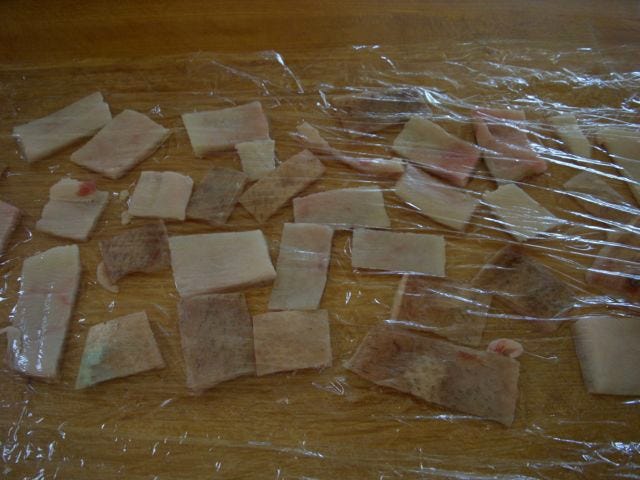Comfort Me with Confit
Those of us who love pigs—alive and cooked—were feeling a little under the weather last week. The headlines from Egypt hurt me viscerally: 300,000 innocent pigs slain, not to feed the hungry, of which there are many on that vast continent, but out of sheer ignorance. I did my bit on Facebook to promote better understanding, but early on it became clear that the only thing that could possibly make me feel better was to get up to my elbows in smooth. creamy lard. So I hauled the last remaining 10-pound roast out of the freezer, from last years half-an-Ossabaw purchase, and softened a few of the many jars of lard I put up last fall. This very tasty breed of pig carries a massive fat cap, not unlike the latest porcine sweetheart-breed, Mangalitsa, and I am traditionally unwilling to waste anything remotely edible. So, last fall I spit-roasted the meat and rendered the fat into lard. Ideal advance preparation for a confit-making session.
In fact, when I unwrapped the roast I could see that this piece of meat would probably have enough of its own fat. From 10 pounds, I diced up seven pounds of pure white fat and 3 pounds of meat (this year, my friendly pig-farmers are crossing their two Ossabaw sows with a Tamworth hog, and we'll certainly see a higher ratio of incredible meat to impeccable fat). The skin, which I will at a later date turn into tooth-challenging, salty-porky cracklings to scatter over a salad, are cut into domino shapes, placed between two pieces of plastic wrap, and frozen. The meat is cut into 1 1/2-inch chunks and rubbed with a mixture of Kosher salt (at 2 teaspoons/pound), dried French thyme, and a hint of nutmeg. It will cure for 24 hours in the fridge (I prefer a 36 to 48-hour cure, but company's comin' and I failed to start the process early enough). The fat heads into a 240F oven to begin rendering. I want the lard to remain between 200 and 205, but I find half an hour at 240F serves to begin the process, and then I must turn the heat down to 210 or so (please note that everyone's oven is different, so don't take this as gospel...). This takes 5 to 6 hours, and testing the temp every hour or so allows me to play the oven like an instrument, nudging up or down to maintain the ideal. Some recipes start with a little water in the pan, but I don't see the point.
I have consulted four different experts before settling, more or less, on a standard hybrid of them all: Paula Wolfert, Judy Rodgers, Bruce Aidells, and Jennifer McLagan (for the crackling, her recipe rules!). Every time I confit, my notes from the last batch help with the refining process. After five confits and two rillettes, I'm starting to feel guardedly confident about the confit. (If you have enough actual pork—as opposed to fat—it's a great time-saver to make both confit and rillettes at the same time. (In my house, this perennially popular French specialty has been Americanized into Pork Butter.)
Part Two of Comfort me with Confit, in which duck fat plays a supporting role, coming on Wednesday.






